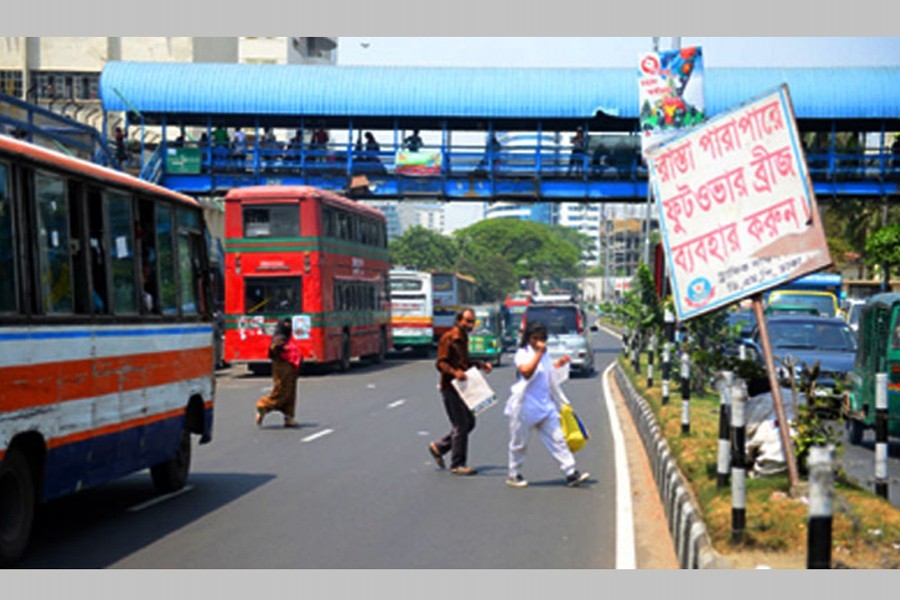
Published :
Updated :

Foot over-bridges, or simply over-bridges hardy stop being subjects of media news in the city of Dhaka. At times it seems sections of pedestrians have become pledge-bound for unknown reasons not to use this safe mode of road-crossing. Instead, they prefer to flaunt their propensity to jaywalk in this city of naked disobedience when it comes to pedestrian movement. In Dhaka, there could be scores of people who have never crossed busy roads by using the over-bridge. They are compulsively defiant people, or their laziness in climbing has reached such an extent that they prefer the risk-filled jaywalking to a safe over-bridge.
These pedestrian bridges have long become associated with Dhaka's modern history of pedestrian movement. Given the general people's anathema for over-bridges, experts feel it is time the traffic authorities sat for an appraisal of the people's use of these mid-road bridges. But, in fact, the need for a thorough review of the proper functions of the bridge has long been felt. Be it a straight short-length bridge across a single road or a circuitous one touching several points of climbing or coming down, a section of pedestrians shows the similar indifference to it. Single-lane bridges now cover the whole capital. The winding ones are located at critical places like the Farmgate area, the Science Laboratory roundabout etc. That Dhaka needs more such long bridges is clearly implied. It's because these road-crossing modes help people use them at their convenient points.
The irony is the Dhaka pedestrians are veritably loath to have the sight of an over-bridge. A common scenario in every part of the capital: A small crowd of well-dressed young men and women begin walking right through a busy road at rush hours. They seem to be least bothered about the rushing minibuses, covered vans, cars and microbuses. They keep coming and going in both directions at full speed. The only duty these pedestrians find worth following is walking straight without looking sideways, their right hand raised with the index finger signalling the traffic to take notice of them. Many a speeding vehicle is seen screeching to a halt to cope with the situation, cropping up abruptly.
A few of the people at the wheel are apparently not that smart to stop their buses or cars right before the defiant men or women. Minor or major accidents follow. Conforming to Dhaka's urban traffic movement culture, the drivers have to take the blame finally. There is a weird aspect to these incidents. A nearly empty over-bridge stands within clear sight. Few bother to take the trouble to go near it, climb its steps and cross the road safely. These bridges, however, do not appear within the range of the jaywalking men and women. An appalling part of the episode is these scenes keep being enacted near schools and colleges, with jittery parents guiding their offspring into crossing spacious roads.
Another grim aspect of these jaywalking styles, undertaken against one's will is there are no foot over-bridges nearby. A sad part of this horrendous situation is road accidents of varying degrees continue to plague these spots. Another abhorrent spectacle has the approach roads and both the climbing segments at the opposite ends of a bridge remaining lined with hawkers. They leave a narrow strip between the two rows for shopping, not for bridge crossing comfortably. Comfort-loving bridge users, especially women, thus, either learn how to use these overcrowded overhead passages, or avoid them altogether. Dhaka needs more over-bridges to cater to the burgeoning numbers of pedestrians. But proper materialisation of them remains elusive; the two hindrances being bridge-hawkers and the pedestrians' unwillingness to use even a thinly crowded over-bridge. The city, has, thus to learn to get used to the overbridge conundrum.


 For all latest news, follow The Financial Express Google News channel.
For all latest news, follow The Financial Express Google News channel.